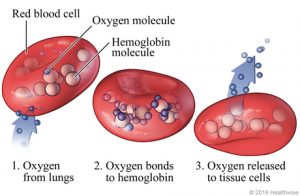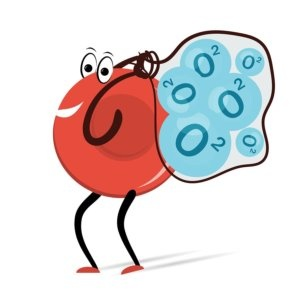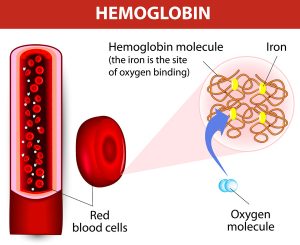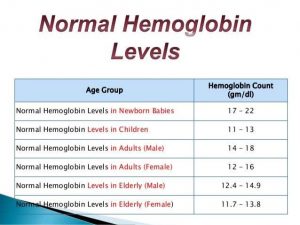Hemoglobin


 Hemoglobin, also known as Hb and Hgb, is a protein that’s contained within your red blood cells (RBCs) that carries oxygen to, and carbon dioxide away from, the rest of the cells in your body. Without the right amount of hemoglobin in your red blood cells, your other cells cannot function at their optimal levels.
Hemoglobin, also known as Hb and Hgb, is a protein that’s contained within your red blood cells (RBCs) that carries oxygen to, and carbon dioxide away from, the rest of the cells in your body. Without the right amount of hemoglobin in your red blood cells, your other cells cannot function at their optimal levels.

Causes
Some of the more common causes of anemia are:
• loss of blood (traumatic injury, surgery, bleeding, colon cancer, or stomach ulcer)
• nutritional deficiency (iron, vitamin B12, folate)
• bone marrow problems (replacement of bone marrow by cancer)
• suppression by red blood cell synthesis by chemotherapy drugs
• kidney failure
• abnormal hemoglobin structure (sickle cell anemia or thalassemia)
Anemia is common in patients with heart disease. It is present in approximately one third of patients with congestive heart failure (CHF) and 10% to 20% of patients with coronary heart disease (CHD). The cause of anemia in heart disease is not fully understood.
Symptoms and Signs
The symptoms of anemia may range from mild and minimal to severe and incapacitating, potentially even life-threatening. It may be difficult to carry out normal, everyday activities. With hypoxia, the heart has to work harder to support the body.
Anemia can affect many systems in the body and produce a variety of symptoms and signs that affect one’s health including:
• Dizziness
• Weakness
• Pallor
• Headache
• Cold hands and feet
• Numbness
• Low body temperature
• Hypoxia
When hypoxia is present, the heart has to work harder to deliver adequate oxygen to the body. This may contribute to several cardiac-related symptoms including shortness of breath, chest pain, low blood pressure, and arrhythmia.

When someone is anemic, the body doesn’t have enough healthy red blood cells to carry oxygen to the rest of the body—making it challenging to exercise. Exercising with anemia is possible as long you don’t overexert yourself. Listen to your body’s needs and act accordingly.
General Guidelines
1. Start off slow. Anemia results in a feeling of fatigue due to a lack of oxygen circulating through the body. Start exercising/workouts slow and progressively increase the intensity over time.
2. Take breaks often . Always listen to your body—if you feel tired, pause and assess whether or not you can continue. Also, only do what you can. Pushing yourself to your limit is not necessary, so if you feel exhausted, sit down and catch your breath.
3. Shorten your physical activity. Any amount of exercise is better than none. Bouts of exercise don’t have to be long to be beneficial. Shorter workouts, such as walking around the block or climbing stairs, add up and contribute to your weekly physical activity goal.
Precautions
1. Do not exercise if resting blood pressure is greater than 180/110 mmHg.
2. Stop exercising immediately if you experience chest pain or angina, labored breathing or extreme fatigue
3. High-intensity exercise and dehydration may increase the risk of sickle cell crisis.
OT Intervention Guidelines
Maintaining/improving a patient’s physical activity (as long as it is safe for the patient and approved by the physician) is important as a long-term reduction in physical activity can lead to secondary deconditioning effects for both the cardiovascular and musculoskeletal systems.
1. Patients with anemia will need close and ongoing monitoring of their heart rate, oxygen saturation levels, and dyspnea levels during exercise sessions.
2. Exercise intensities can be self-assessed by perceived exertion levels or by taking the patient’s heart rate levels during the physical activity.
3. Monitoring of oxygen saturation and heart rate will help determine when patients are exercising in a state of decreased blood oxygen.
4. The parameters of exercise will need to be appropriate for the patients’ primary or secondary condition that has created their anemia.
5. Daily levels of fatigue should be assessed to prescribe an appropriate level of exercise based on patients’ progression or deterioration.
Resources:
https://annals.org/aim/fullarticle/1784292/treatment-anemia-patients-heart-disease-clinical-practice-guideline-from-american
https://www.sharecare.com/health/anemia-blood-disorders/article/ways-safely-exercise-anemia
https://www.medscape.com/viewarticle/719391
https://academic.oup.com/ajcn/article/72/2/594S/4729672
https://www.medicinenet.com/hemoglobin/article.htm
https://www.emedicinehealth.com/hemoglobin_levels/article_em.htm#what_is_hemoglobin
Exercise Prescription for Medical Conditions: Handbook for Physical Therapists- Catherine Goodman, Kevin Helgeson